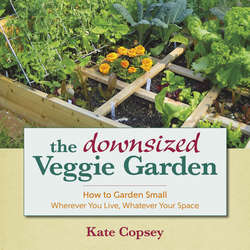Читать книгу The Downsized Veggie Garden - Kate Copsey - Страница 9
На сайте Литреса книга снята с продажи.
ОглавлениеIntroduction
This book came out of a discussion with a fellow garden writer, Doug Oster. I was in the middle of relocating from my old home, which had a nice, spacious garden, and was living in a temporary apartment when seed-sowing time came around. I told Doug I couldn’t figure out what to sow or where to germinate the seeds, let alone where I was going to grow them! I joked that I needed to write a book on this downsizing thing. Many months and several discussions with Doug later, I approached his publisher, St. Lynn’s Press – and here we are. My family did finally move to a permanent home, though much smaller in both square footage and in space to grow vegetables compared to our last home. We are not totally downsized yet, but the lessons learned from that apartment and current challenges in our smaller home – as well as meeting other gardeners who are growing in small spaces – are what this book is all about.
Over the years, we have moved from a simple rental when we first got married to larger properties as the kids came along. It was not until the boys left to make their own lives that we started to go the other way. We didn’t need space for the soccer ball to be kicked or the golf ball hit, and we certainly didn’t need as many vegetables to feed them. While the boys were growing, I certified as a Master Gardener and became a fan of community gardens that not only feed the community but also bring neighbors together; and I discovered Square Foot Gardening, which made my gardening time so much more productive.
Not everyone travels the same road I did, but I know that growing at least a few vegetables has become a high priority for people of all ages and gardening experience. What might hold someone back is the perception that they need more space than they have available to them. This book is a way to enable all those people who don’t want to, or cannot, till-up the “back 40.” I’m here to affirm that they have plenty of options for growing in compact spaces and gardens: in-ground (in as little as 16 square feet), in containers, on decks, up walls, on windowsills, and even hydroponically, without soil at all.
The new appreciation of garden-fresh vegetables comes from many sides but includes some health scares in the past decade. Parents want to know where their children’s food is coming from and what is put onto that “fresh” vegetable to keep it looking good. When you grow your own veggies you know what they were treated with and when they were harvested. And then there is the rather boring selection found in the local supermarket. People travel to other countries and taste other culinary ingredients only to find that these ingredients are not as readily available back home. Many of those great spices and tasty Italian salad greens can easily be grown in your own small garden.
There is a wealth of great tasting vegetables out there to try, including some that your preteens would turn their nose up at (but maybe not, if they took part in growing them), such as colorful chards, kales and spinach. Now is your chance to enjoy the many colors of tomatoes and other healthy and great tasting vegetables. The trend to growing vegetables in containers and smaller places has led the industry to bring out new cultivars of fruit and vegetables that grow happily in containers. There are even containers that fit snuggly onto a deck railing to optimize your space for seating and entertainment.
If you’ve spent years tending an extensive vegetable plot to help feed the family like I did, living with a smaller space takes some adjusting to. On the other hand, if your gardening experience has been limited to mowing the lawn and pulling weeds from the foundation planting, and you’d like to try your hand at growing some vegetables for the first time, this book shows you how you can do that, and in a way that suits your current lifestyle and your current home style.
Whether the home is rented or purchased, an apartment, a house in suburbia or a “mature adult” development, there are many ways that you can grow at least some of your own fruits and vegetables and enjoy the taste of a one-minute-old tomato, raspberry or apple – from right outside your door!
I invite you to join me as we walk through the decision-making process for planning and planting your downsized garden. Along the way we’ll find the best location for a favorite tomato plant and give you a checklist to make sure the plant will grow there and produce for you. I’ll equip you with simple, practical tips to optimize your enjoyment and save time, work and money. And we’ll hear from some other downsized gardeners who have found space where they live to grow their own favorite veggies – which in one case meant the roof of a garage!
So whether you are new to vegetable gardening or an old hand – in your first home or your last home – you are exactly where you need to be at this time in your life, and I can promise you some great ideas for successful growing.
Kate
